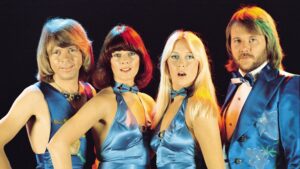In the realm of music diversity, ABBA stands out as a remarkable ensemble that has left an indelible mark on the industry. At the heart of their widespread acclaim is a distinct sound that begs the question: What music genre is ABBA that can truly encapsulate their timeless allure of melodies and rhythms? This introduction delves into the essence of ABBA’s musical identity, seeking to unravel the genre that has made them an enduring force in the history of popular music.
ABBA is widely recognized as a pop music group from Sweden that achieved global success during the 1970s. Their music is predominantly classified within the pop genre, characterized by catchy melodies, harmonies, and polished production.
While rooted in pop, ABBA’s sound also incorporates elements of disco, showcasing a vibrant and danceable style. The group’s ability to create infectious tunes with universal appeal has contributed to their enduring popularity, solidifying their status as one of the most celebrated and influential acts in the history of pop music.
ABBA is a Swedish pop group that rose to international fame in the 1970s and became one of the most successful and iconic musical acts in history. The primary music genre associated with ABBA is pop, with a distinctive blend of catchy melodies, harmonies, and upbeat rhythms.
Their music often features a mix of pop, disco, and Eurovision influences, characterized by infectious hooks and polished production. ABBA’s timeless and universally appealing sound has made them a cornerstone of pop music, and their legacy continues to influence artists across various genres.
What is the primary music genre that ABBA is associated with?
The primary music genre associated with ABBA is pop. ABBA’s music is characterized by catchy melodies, harmonies, and polished production, making them one of the most iconic and successful pop acts in the history of music. While rooted in pop, their sound also incorporates elements of disco, contributing to their distinct and universally appealing style.
ABBA’s music, firmly anchored in the pop genre, showcases a unique blend of infectious hooks, upbeat rhythms, and emotionally resonant lyrics. Their ability to craft catchy, radio-friendly tunes with sophisticated arrangements set them apart in the pop landscape. The group’s prominence in the 1970s disco era is evident in some of their hits, such as “Dancing Queen” and “Gimme! Gimme! Gimme! (A Man After Midnight),” where they seamlessly incorporated disco elements into their signature pop sound.
Beyond the catchy tunes and danceable beats, ABBA’s songwriting prowess and vocal harmonies have contributed to their enduring appeal. The quartet’s ability to infuse emotion and storytelling into their pop compositions has elevated their music to a level that transcends typical genre boundaries. As a result, while pop is the cornerstone of their musical identity, ABBA’s impact extends across various genres and continues to influence a diverse range of artists.
Which genre elements does ABBA’s music incorporate alongside pop?
Alongside their primary association with pop music, ABBA’s musical repertoire incorporates elements from the disco genre. The 1970s disco era significantly influenced some of ABBA’s most iconic hits, such as “Dancing Queen” and “Gimme! Gimme! Gimme! (A Man After Midnight).” These songs feature the characteristic danceable rhythms, four-on-the-floor beats, and orchestral arrangements commonly associated with disco music.
ABBA’s seamless integration of disco elements into their pop sound demonstrates their versatility and ability to adapt to prevailing musical trends. The result is a fusion of pop and disco that contributes to the infectious and timeless quality of their music, showcasing the group’s innovative approach within the broader spectrum of popular music.
How did ABBA’s music evolve over their career in terms of genre?
ABBA’s music evolved over their career, showcasing a dynamic range of styles while maintaining their foundation in pop. In the early years, their music was influenced by the upbeat and catchy pop tunes of the 1970s, evident in hits like “Waterloo” and “SOS.” As their career progressed, especially in the late 1970s, ABBA embraced elements of disco, infusing their sound with danceable rhythms and orchestrations, as seen in iconic tracks like “Dancing Queen.”
In the later stages of their career, particularly with the release of the album “Super Trouper” in 1980, ABBA incorporated a more mature and reflective tone in their music. While still rooted in pop, their compositions began to explore themes of nostalgia and introspection, adding layers of complexity to their songwriting.
Despite these stylistic shifts, ABBA consistently maintained their signature harmonies, melodic richness, and polished production throughout their discography. Their ability to adapt to changing musical landscapes while retaining a distinctive sound contributed to the enduring appeal of their music across different eras.
What were the key musical influences on ABBA’s sound?
ABBA’s sound was shaped by a variety of musical influences that contributed to their distinctive and timeless style. Some key influences include:
- Pop Music of the 1960s: ABBA drew inspiration from the melodic and catchy pop music of the 1960s, incorporating elements of this era’s songwriting into their early compositions. The influence of classic pop acts can be heard in their use of memorable hooks and harmonies.
- Rock ‘n’ Roll and Rockabilly: The members of ABBA, particularly Benny Andersson and Björn Ulvaeus, were influenced by the rock ‘n’ roll and rockabilly genres. This influence is evident in some of their up-tempo and rhythmically-driven songs, adding a lively and energetic dimension to their music.
- Swedish Folk Music: Being a Swedish group, ABBA occasionally incorporated elements of Swedish folk music into their compositions. This influence can be heard in certain instrumental arrangements and folk-inspired melodies, providing a unique touch to their sound.
- Disco: In the late 1970s, ABBA embraced the disco phenomenon that was sweeping the music scene. This is particularly evident in songs like “Dancing Queen” and “Gimme! Gimme! Gimme! (A Man After Midnight),” where disco rhythms and orchestration play a prominent role.
- Eurovision Music: ABBA’s breakthrough came with their victory in the 1974 Eurovision Song Contest with “Waterloo.” The Eurovision influence is seen in their ability to create songs with broad audience appeal and memorable choruses, a hallmark of many Eurovision entries.
By skillfully blending these influences, ABBA created a sound that transcended specific genres, contributing to their widespread popularity and enduring legacy in the world of popular music.
How did ABBA’s music contribute to the development of the Europop genre?
ABBA played a significant role in the development and popularization of the Europop genre. Europop, a genre characterized by its catchy melodies, electronic elements, and a strong emphasis on accessibility, gained prominence in Europe during the late 20th century. ABBA’s contributions to this genre are evident in several key aspects:
- International Success: ABBA’s unprecedented international success helped elevate Europop onto the global stage. Their ability to transcend linguistic and cultural barriers showcased the universal appeal of the genre, paving the way for other European pop artists to find international recognition.
- Melodic Craftsmanship: ABBA’s songs were known for their exceptionally well-crafted melodies and harmonies. This emphasis on strong, memorable tunes became a hallmark of Europop, influencing subsequent artists within the genre to prioritize catchy and accessible musical arrangements.
- Innovative Production Techniques: ABBA was at the forefront of adopting innovative production techniques, incorporating synthesizers and electronic elements into their music. This experimentation with technology helped shape the sound of Europop, which often features a blend of electronic and traditional instrumentation.
- Eurovision Impact: ABBA’s victory in the 1974 Eurovision Song Contest with “Waterloo” brought the Europop genre to a wider audience. The song’s infectious energy, coupled with the group’s dynamic stage presence, set a standard for future Eurovision entries and contributed to the genre’s evolution.
- Diverse Cultural Influences: ABBA’s Swedish roots added a unique flavor to their music, infusing elements of Scandinavian folk into their pop sound. This blend of diverse cultural influences became characteristic of Europop, as artists across Europe began to incorporate their own cultural nuances into the genre.
In essence, ABBA’s musical contributions not only shaped the Europop genre but also played a pivotal role in establishing European pop music as a force with global appeal. The group’s influence continues to resonate in the work of contemporary Europop artists, marking ABBA’s enduring impact on the landscape of popular music.
What are some of ABBA’s most iconic songs within the pop genre?
ABBA has a rich discography filled with iconic songs that have become synonymous with the pop genre. Some of their most iconic pop songs include:
- “Dancing Queen” (1976): Widely regarded as one of ABBA’s signature songs, “Dancing Queen” is a disco-infused pop anthem known for its infectious beat and uplifting vibe. It became a global hit and remains one of the most celebrated pop songs of all time.
- “Mamma Mia” (1975): With its catchy chorus and upbeat tempo, “Mamma Mia” is another standout pop hit that showcases ABBA’s talent for creating irresistibly catchy tunes. The song gained renewed popularity when it inspired the hit musical and film of the same name.
- “Waterloo” (1974): The song that propelled ABBA to international fame, “Waterloo” won the Eurovision Song Contest in 1974. It combines pop, rock, and Eurovision influences, marking a pivotal moment in the group’s career.
- “Take a Chance on Me” (1978): Known for its unique vocal arrangement and memorable chorus, “Take a Chance on Me” is a pop classic that reflects ABBA’s ability to blend sophistication with accessibility.
- “Gimme! Gimme! Gimme! (A Man After Midnight)” (1979): This disco-influenced pop track features a danceable beat and showcases ABBA’s adaptation to the disco trend of the late 1970s. It remains a favorite on dance floors around the world.
- “The Winner Takes It All” (1980): With its poignant lyrics and emotive delivery, this ballad demonstrates ABBA’s versatility within the pop genre. It became one of their most successful and enduring songs.
- “Knowing Me, Knowing You” (1976): This pop ballad explores themes of heartbreak with its poignant lyrics and showcases ABBA’s ability to infuse emotion into their music while maintaining a pop sensibility.
These songs, among others in ABBA’s catalog, exemplify the group’s mastery of the pop genre and their enduring influence on the world of popular music.
What are some of the subgenres of pop that ABBA’s music can be categorized under?
ABBA’s music can be categorized under various subgenres of pop, reflecting their versatility and ability to incorporate different influences into their sound. Some of the subgenres of pop that can be associated with ABBA’s music include:
- Disco Pop: ABBA’s music from the late 1970s, particularly songs like “Dancing Queen” and “Gimme! Gimme! Gimme! (A Man After Midnight),” reflects the disco-pop trend of the era. These tracks feature danceable beats, orchestral arrangements, and a lively energy characteristic of disco music.
- Euro Pop: As a Swedish group that gained international acclaim, ABBA’s music is often associated with the Euro pop genre. The Eurovision-winning “Waterloo” and their overall emphasis on catchy melodies align with the conventions of Euro pop.
- Adult Contemporary Pop: Some of ABBA’s ballads, such as “The Winner Takes It All” and “Thank You for the Music,” fall into the adult contemporary pop category. These songs showcase a more mature and reflective side of their songwriting.
- Folk Pop: While not the dominant genre, elements of Swedish folk music can be heard in certain aspects of ABBA’s sound. The incorporation of folk-inspired melodies and occasional traditional instrumentation adds a unique flavor to their pop compositions.
- Soft Rock Pop: In their later years, ABBA explored a softer, more introspective sound. Songs like “Chiquitita” and “I Have a Dream” exhibit elements of soft rock pop, with a focus on melodic storytelling and acoustic arrangements.
- Synth-pop (later years): In the early 1980s, ABBA incorporated synthesizers and electronic elements into their music, aligning with the emerging synth-pop trend. While this was a departure from their earlier sound, it showcased their adaptability to evolving musical landscapes.
Overall, ABBA’s diverse catalog encompasses a range of pop subgenres, making them a dynamic and influential force in the pop music landscape.
How did ABBA’s music impact other artists and genres?
ABBA’s music has had a profound and enduring impact on other artists and various genres, contributing to the evolution of popular music in several ways:
- Influence on Pop Music: ABBA’s catchy melodies, polished production, and harmonies have influenced countless pop artists. Their ability to create universally appealing songs has set a standard for pop music craftsmanship, inspiring subsequent generations of pop musicians to prioritize melodic richness and accessibility.
- Disco Revival: During the disco era of the late 1970s, ABBA’s disco-infused hits like “Dancing Queen” played a significant role in the genre’s popularity. Their success contributed to the global disco phenomenon and influenced other artists exploring disco elements in their music.
- Eurovision Impact: ABBA’s victory in the 1974 Eurovision Song Contest with “Waterloo” not only marked a turning point in their career but also influenced the perception of the Eurovision platform. The group’s triumph showcased that winning Eurovision could lead to international success, inspiring subsequent Eurovision participants to aim for broader recognition.
- Dance and Pop Fusion: ABBA’s danceable beats and energetic rhythms, especially in songs like “Gimme! Gimme! Gimme! (A Man After Midnight),” have left a lasting impact on the fusion of dance and pop music. The group’s ability to create music that transcends traditional genre boundaries has influenced dance-pop and electronic-pop artists.
- Sampling and Covers: Many contemporary artists have sampled or covered ABBA’s songs, showcasing the timelessness of their music. Their tracks have been reinterpreted across various genres, from hip-hop to indie pop, demonstrating the enduring relevance of their compositions.
- Songwriting Excellence: ABBA’s sophisticated songwriting, often exploring themes of love, heartbreak, and self-discovery, has set a benchmark for excellence in pop songwriting. Other artists have looked to ABBA for inspiration in crafting emotionally resonant and well-structured songs.
- Global Impact: ABBA’s international success demonstrated that non-English language acts could achieve global acclaim. This paved the way for other non-English-speaking artists to pursue international careers, contributing to the globalization of the music industry.
In summary, ABBA’s influence extends beyond their specific genre, impacting the broader landscape of popular music and inspiring artists across various genres and regions. Their legacy continues to be felt in the melodies, production techniques, and timeless appeal that characterize their extensive catalog.
What are some of the characteristics of ABBA’s music that define it as pop?
ABBA’s music is defined as pop due to several distinctive characteristics that align with the genre. Some key features of ABBA’s pop sound include:
- Catchy Melodies: One of the hallmarks of ABBA’s music is its irresistibly catchy melodies. Their songs are known for their memorable hooks and sing-along quality, contributing to their widespread popularity.
- Harmonies: ABBA’s vocal harmonies are a defining element of their sound. The group’s members, Agnetha Fältskog, Björn Ulvaeus, Benny Andersson, and Anni-Frid Lyngstad, blended their voices seamlessly to create rich and harmonically sophisticated arrangements.
- Polished Production: ABBA’s music is characterized by high-quality and polished production. Their songs often feature meticulous studio work, showcasing a level of sophistication in arrangement and instrumentation that is typical of pop music.
- Upbeat Rhythms: Many of ABBA’s hits are driven by upbeat and danceable rhythms. Songs like “Dancing Queen” and “Waterloo” feature lively tempos that contribute to the overall joyous and energetic feel of their music.
- Accessible Themes: The lyrics of ABBA’s songs often explore universal themes of love, relationships, and self-discovery. The relatable and accessible nature of their lyrics has contributed to the broad appeal of their music.
- Versatility: ABBA’s ability to incorporate diverse influences into their pop sound showcases their versatility. Whether drawing from disco, rock, or folk, they maintained a core pop sensibility that allowed them to navigate different musical landscapes.
- Memorable Choruses: ABBA was adept at creating memorable and singable choruses. Their songs are characterized by strong, anthemic choruses that make them easily recognizable and memorable to listeners.
- Innovative Use of Technology: Particularly in their later years, ABBA embraced innovative production techniques and technology. They incorporated synthesizers and electronic elements into their music, reflecting an adaptability to evolving trends in pop music.
- Global Appeal: ABBA’s music transcends cultural and linguistic boundaries, contributing to its global appeal. The group’s success in reaching international audiences highlighted the universal nature of their pop sound.
These characteristics collectively define ABBA’s music as pop, and their ability to balance sophistication with accessibility has solidified their place as one of the most iconic pop acts in music history.
How did ABBA’s production techniques and instrumentation influence the pop genre?
ABBA’s production techniques and instrumentation played a significant role in influencing the pop genre, contributing to the evolution of popular music in the following ways:
- Sophisticated Arrangements: ABBA’s music is characterized by meticulously crafted and sophisticated arrangements. The group, along with their producer Benny Andersson, employed innovative studio techniques to create layered and multi-dimensional soundscapes. This emphasis on intricate arrangements set a standard for pop music production, influencing subsequent artists to explore greater complexity in their musical compositions.
- Vocal Harmonies: ABBA’s exceptional vocal harmonies, a result of the seamless blending of the two female and two male voices, became a signature element of their sound. The group’s ability to create intricate and compelling vocal harmonies set a benchmark for pop music, inspiring other acts to prioritize vocal arrangements as a key aspect of their production.
- Effective Use of Studio Technology: ABBA embraced emerging studio technologies of their time, such as synthesizers and electronic instruments. Their innovative use of these tools, particularly in their later years, contributed to the integration of electronic elements into pop music. This willingness to experiment with technology helped shape the sound of subsequent pop and electronic genres.
- Catchy Hooks and Melodies: ABBA’s emphasis on crafting catchy hooks and melodies became a defining feature of their music. The meticulous attention to creating memorable and singable tunes influenced the pop genre’s overall approach to songwriting. The focus on infectious melodies became a hallmark of successful pop compositions.
- Varied Instrumentation: ABBA incorporated a diverse range of instruments into their arrangements, including pianos, synthesizers, strings, and horns. This eclectic instrumentation added richness to their sound and expanded the sonic palette of pop music. The willingness to experiment with diverse instruments encouraged other artists to explore unconventional sounds within the pop genre.
- Orchestral Elements: ABBA often utilized orchestral arrangements in their music, blending classical elements with pop sensibilities. This fusion of orchestral and pop music set a precedent for later artists to experiment with symphonic arrangements within a popular music context.
- International Fusion: ABBA’s global success and incorporation of various musical influences from different cultures demonstrated the possibilities of creating universally appealing pop music with an international flavor. This influence encouraged other artists to embrace diverse cultural elements in their own work.
In summary, ABBA’s production techniques and instrumentation not only defined their own sound but also left an indelible mark on the pop genre. Their innovative approach to studio work, vocal arrangements, and musical experimentation influenced subsequent generations of pop musicians and contributed to the ongoing evolution of popular music.
What are some of the critical and commercial successes that ABBA achieved within the pop genre?
ABBA achieved numerous critical and commercial successes within the pop genre, solidifying their status as one of the most iconic and successful musical acts in history. Here are some of their notable achievements:
- Eurovision Victory (1974): ABBA gained international recognition by winning the Eurovision Song Contest in 1974 with the song “Waterloo.” This victory marked a turning point in their career and contributed to their global success.
- Chart-Topping Hits: ABBA produced a string of chart-topping hits that became synonymous with the pop genre. Some of their most successful singles include “Dancing Queen,” “Mamma Mia,” “Take a Chance on Me,” and “Knowing Me, Knowing You.”
- Global Album Sales: ABBA’s albums achieved staggering commercial success worldwide. Their studio albums, such as “Arrival,” “ABBA: The Album,” and “Super Trouper,” sold millions of copies and consistently topped international charts.
- “Dancing Queen” (1976): Often considered one of the greatest pop songs of all time, “Dancing Queen” became a global phenomenon. It topped charts in numerous countries and remains one of ABBA’s most enduring and celebrated hits.
- Record-Breaking Sales: ABBA’s compilation album, “ABBA Gold: Greatest Hits,” released in 1992, became one of the best-selling albums of all time. It has sold over 30 million copies worldwide, highlighting the enduring popularity of their music.
- Album “ABBA: The Album” (1977): This album, featuring hits like “The Name of the Game” and “Take a Chance on Me,” reached the number one spot on the charts in multiple countries and showcased the group’s consistent success.
- “The Winner Takes It All” (1980): This poignant ballad became one of ABBA’s most successful singles, reaching high positions on charts globally and showcasing the group’s ability to evoke emotion within the pop genre.
- Cultural Impact: ABBA’s music has had a lasting cultural impact, with their songs featured in numerous films, commercials, and stage productions. The musical “Mamma Mia!” based on their songs became a global phenomenon and further solidified their influence on popular culture.
- Induction into the Rock and Roll Hall of Fame (2010): In recognition of their immense contribution to the music industry, ABBA was inducted into the Rock and Roll Hall of Fame, further underscoring their influence within the pop genre.
ABBA’s critical acclaim, chart dominance, and record-breaking sales are testaments to their unparalleled success within the pop genre, and their music continues to resonate with audiences worldwide.
How did ABBA’s music shape the landscape of popular music in the 1970s and beyond?
ABBA’s music played a pivotal role in shaping the landscape of popular music in the 1970s and beyond, leaving a lasting impact on various aspects of the industry:
- Global Pop Sensation: ABBA’s unprecedented success on the international stage helped redefine the concept of a global pop sensation. Their ability to transcend language and cultural barriers demonstrated that music with universal appeal could achieve widespread acclaim, influencing the globalization of the music industry.
- Disco Influence: During the late 1970s, ABBA’s incorporation of disco elements into their music, especially in songs like “Dancing Queen,” contributed to the disco phenomenon. They seamlessly blended pop and disco, influencing the sound of the era and leaving an indelible mark on dance music.
- Eurovision Impact: ABBA’s victory in the 1974 Eurovision Song Contest with “Waterloo” elevated the competition’s status and showcased that winning Eurovision could lead to international success. This influenced subsequent Eurovision participants and contributed to the event’s role in launching global careers.
- Studio Innovation: ABBA’s innovative use of studio technology and sophisticated production techniques set a standard for excellence in studio craftsmanship. Their meticulous attention to detail in arranging and producing their music influenced the way artists approached recording and production, contributing to the advancement of studio techniques.
- Crossover Success: ABBA’s ability to appeal to a broad audience, including pop, rock, and disco fans, showcased the potential for crossover success. Their music reached listeners across different demographics, demonstrating the power of versatile and accessible pop music.
- Legacy in Musicals: The success of the musical “Mamma Mia!” based on ABBA’s songs further extended their impact. The musical’s global popularity demonstrated the enduring appeal of ABBA’s music and its adaptability across different artistic mediums.
- Songwriting Prowess: ABBA’s sophisticated songwriting, characterized by well-crafted melodies and emotive lyrics, influenced subsequent generations of pop songwriters. Their ability to create timeless and relatable songs set a standard for excellence in pop songcraft.
- Synth-Pop Exploration: In their later years, ABBA embraced synthesizers and electronic elements, contributing to the evolution of the synth-pop genre. This experimentation foreshadowed the electronic music trends that would become prominent in the 1980s.
- Cultural Impact: ABBA’s cultural impact extends beyond their musical contributions. Their iconic fashion sense, memorable album covers, and distinctive personalities contributed to their status as pop culture icons, influencing trends in fashion and entertainment.
ABBA’s influence in the 1970s and beyond is marked by their ability to innovate within the pop genre, shape musical trends, and create a lasting legacy that continues to resonate with audiences across the globe.
What is ABBA’s legacy in terms of their impact on the pop music genre?
ABBA’s legacy in the pop music genre is substantial and enduring, marked by their profound impact on various aspects of the industry. Here are key facets of ABBA’s legacy within the pop music genre:
- Global Icon Status: ABBA achieved unprecedented global success, becoming one of the most iconic pop groups in history. Their ability to transcend cultural and linguistic boundaries established them as a symbol of international pop excellence.
- Pioneers of Pop-Disco Fusion: ABBA’s seamless incorporation of disco elements into their pop sound during the late 1970s played a crucial role in popularizing the pop-disco fusion. Songs like “Dancing Queen” showcased their influence on the disco movement, contributing to the genre’s widespread popularity.
- Timeless Hits: ABBA’s catalog is replete with timeless hits that continue to resonate across generations. Songs like “Dancing Queen,” “Mamma Mia,” and “Waterloo” remain staples in popular culture and are celebrated for their enduring appeal.
- Innovative Studio Techniques: ABBA’s commitment to innovative studio techniques and production excellence set a standard for craftsmanship in the pop genre. Their meticulous attention to detail and willingness to experiment with technology influenced the way artists approached recording and production.
- Versatility and Adaptability: ABBA showcased remarkable versatility by seamlessly blending various musical styles into their pop sound, including elements of disco, folk, and rock. This adaptability allowed them to remain relevant across changing musical landscapes.
- Eurovision Legacy: ABBA’s victory in the Eurovision Song Contest with “Waterloo” not only launched their international career but also left a lasting impact on the perception of Eurovision as a platform for launching successful pop acts.
- Songwriting Excellence: The songwriting prowess of ABBA, characterized by catchy melodies, sophisticated harmonies, and emotionally resonant lyrics, set a benchmark for excellence in pop songcraft. Their ability to craft universally relatable songs influenced subsequent generations of pop songwriters.
- Crossover Appeal: ABBA’s music appealed to a broad audience, transcending age, language, and cultural barriers. Their crossover success demonstrated the potential for pop music to connect with diverse demographics, influencing the industry’s approach to reaching a global audience.
- Cultural Phenomenon: ABBA became a cultural phenomenon, influencing not just music but also fashion, art, and entertainment. Their impact extends beyond the sonic realm, with their iconic fashion sense, album covers, and imagery contributing to their status as pop culture icons.
- Enduring Popularity: Decades after their initial success, ABBA’s music continues to enjoy widespread popularity. Their songs are frequently featured in films, commercials, and stage productions, attesting to the enduring and cross-generational appeal of their pop sound.
In essence, ABBA’s legacy in the pop music genre is characterized by their innovation, international success, and the timeless quality of their music, which collectively have left an indelible mark on the landscape of popular music.
Conclusion
ABBA’s musical legacy is firmly rooted in the pop genre, where their unparalleled success, innovative sound, and timeless hits have left an indelible mark on the landscape of popular music, which is why we have been looking into what music genre is ABBA.
From their Eurovision victory with “Waterloo” to the disco-infused anthems like “Dancing Queen,” ABBA‘s ability to seamlessly blend catchy melodies, sophisticated harmonies, and diverse influences showcases their mastery of the pop genre.
Their impact extends beyond musical boundaries, influencing global perceptions of Eurovision, shaping the evolution of studio techniques, and setting a standard for songwriting excellence.






